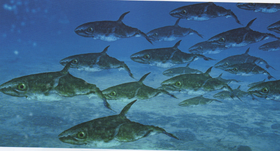
A school of Ichthyosepia scombrus
With about 800 species living in nature today, cephalopods are a class of mollusks that have had some evolutionary success and have been present for nearly 500 million years, since the Late Cambrian. They were even the super-predators of the seas and oceans repeatedly over geological time (e.g. Tusoteuthis from the Cretaceous). Today-hui, cephalopods are distributed in all seas and oceans of the world, especially in great depth, and are considered the "invertebrates" the most intelligent, that is, those with the best cognitive (memory , learning ...). We relied on the evolutionary potential of cephalopods to imagine the great family of Rhombosepidae, from the current cuttlefish. This new family will know, we think, a real boom with the extinction of most fish (bone and cartilage) and cetaceans that will mark the future of our oceans. the ecological niches will be quickly freed occupied by these cephalopods. The merger or réeduction tentacles and processing coat side fin, dorsal or ventral promote the appearance of many species.
Delphimimus jamescameroni[]
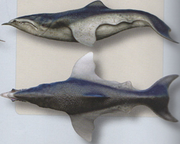
Delphimimus jamescameroni
The species Delphimimus jamescameroni (named in honor of Canadian filmmaker, director, producer, screenwriter, inventor, engineer, philanthropist, and deep-sea explorer James Cameron), is a fish-eater, like current dolphins. It measures 1.5 meters long. The amazing Delphimimus, genus literally means "one that mimics the dolphin". Its reproduction is epic: when breeding season comes, the male dances before each female to be in his harem.
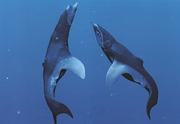
The mating dance of the male (left) in front of the female (right). The male can dance for hours in order to attract females into his harem.
The female chooses the male with whom she will mate. After consenting the female, the male reproductively gently inserts one tentacle into the mouth of the female, as current cuttlefish do to lay their -capsules spermatophores containing sperm. Once fertilized sperm, the female lays her eggs in clusters. They remain attached to the female (in pelagic forms) or are deposited in the crevices of rocks (in coastal forms).
Rhombosepia megarhynchus[]
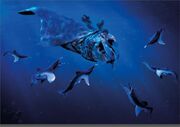
The beak of death: the large cephalopod Rhombosepia megarhynchus, armed with his enormous beak, shearing his cousin Delphimimus jamescameroni.
The ferocious predator Rhombosepia megarhynchus (3 meters) has more tentacles, but a hypertrophied and extendable spout which allows him to cut his victims before devouring them.
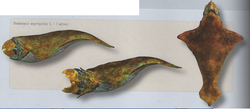
Rhombosepia megarhynchus
The male R. megarhynchus, no longer tentacle, spits his semen in the mouth of the female.
Ichthyosepia scombrus and Ichthyosepia muttereri[]
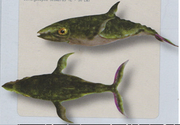
Ichthyosepia scombrus
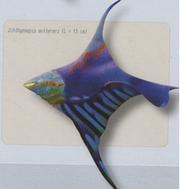
Ichthyosepia muttereri
The kind Ichthyosepia present, as its implies, astonishing similarities with some current bony fish: Ichthyosepia scombrus (30 cm long), feeding on Stegoichthys (yet I. scombrus can be prey itself to Propellonectes, Neopygoscelis and other Rhombosepids), mackerel look to, lives in organized bench while Ichthyosepia muttereri (15cm long), coastal species, is beholden to the warm tropical waters and grazes neo-coral.
